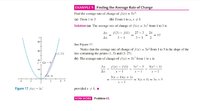This is the kind of question I like to see people asking, rather than just "Did I do the mechanics right?" You want to understand meaning -- and not doing so is why so many students fail to really learn.
And an answer requires a dialogue, to find what it takes to help you see the meaning. And you've made a start at that, by suggesting a possibility. The odd thing is, I expect a textbook to explain average rate of change thoroughly before even mentioning the derivative; we're not talking about the derivative at all at this point. The derivative is the
instantaneous rate of change. And in order for "the average rate of change of the derivative" to mean anything to you, you first have to have a sense of what your question itself means -- what is an "average rate of change" of anything?
One example of AROC, likely mentioned in your book, is
average speed, which is the average rate of change of
position over some period of time. If a car starts at position A on a line at time a, and moves to position B by time b (not necessarily at a constant speed, but perhaps accelerating and decelerating), the
average speed is the
constant speed that would be required to get from A to B in the
same time. The distance it's gone is B - A, and the time it took is b - a, so the average speed is (B - A)/(b - a).
Another example is
slope. If you graph a function f, so that f(a) = A and f(b) = B, the average rate of change from a to b is the slope of the line between those two points on the graph, (a, A) and (b, B) -- that is, (a, f(a)) and (b, f(b)). The slope of that line is (f(b) - f(a))/(b - a).
In other words, AROC is just the slope you've been learning about all through algebra and precalculus, but applied specifically to any two points on a curve. It isn't yet calculus! Calculus starts when you take limits, and in this case limits of AROC's -- which are called derivatives. This is commonly covered, at least in part, in precalculus books.
Now, since you presumably read the book and/or watched a video that talked about all this, you probably need something more in order to grasp it. Can you tell me any part of this that you need more help with?
Also, in case your book (or video) didn't spend enough time on the topic to see the meaning, here is one that may:
In this section, we will investigate changes in functions. For example, a rate of change relates a change in an output quantity to a change in an input quantity. The average rate of change is …

math.libretexts.org


